MakerGirl Seeks to Expand the STEM Pipeline by Getting Middle School Girls Interested in STEM
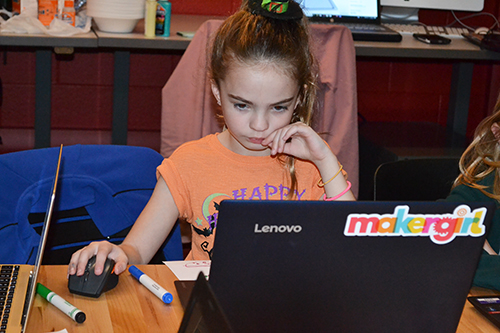
A young "MakerGirl" uses TinkerCAD to make her Halloween-themed design on the computer during a recent MakerGirl session.
November 2, 2018
Excited about having some pre-Halloween fun with STEM, six local middle-school girls showed up at the Armory’s Innovation Lab on Tuesday, October 30th, for MakerGirl. During the two-hour session, the 7–10-year-old girls learned how to use Tinker-CAD, a computer-aided-design application for kids, discovered how 3D printers work, then 3D printed Halloween-related designs they’d made. Plus, currently all the rage and completely apropos for Halloween, they made some ooey-gooey slime.
MakerGirl is a STEM education outreach program whose mission is to inspire girls to be active in STEM, to “live and dream as unstoppable forces that say yes to the challenges of the future.” Its ultimate goal? To channel more girls into the STEM Pipeline in order to foster “gender equality in all workplaces,” especially the STEM workforce.
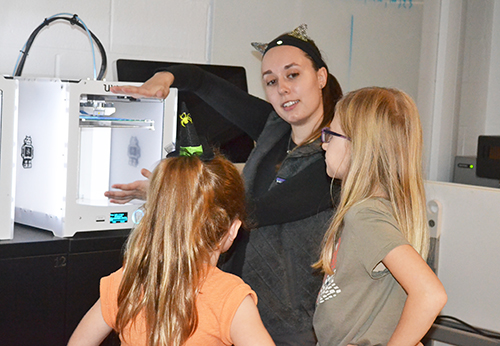
MakerGirl CEO, Stephanie Hein shows young girls the 3D printers.
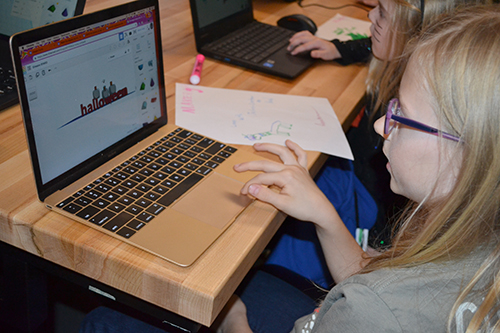
Éireann Byard works on her halloween design on the computer.
Current CEO, Stephanie Hein, who studied molecular biology at Illinois, is quite passionate about the group’s mission. “Women in STEM is close to my heart,” she admits, “and I love giving little girls an opportunity to explore different STEM fields. I would've loved to do something like this as a kid, and I didn't have it. Just providing that opportunity to anyone else is so fun.”
MakerGirl sessions, are usually comprised of 6–10 girls, ages 7–10. Mary Hadley, a senior in chemistry at Illinois and currently the group’s managing and curriculum director, explains why they’re targeting that age group. “So we really want to reach that age range right before middle school,” she says, “because we found it's right around middle school when girls start saying ‘No!’ to STEM activities and also just feeling discouraged in their classes.” So MakerGirl picked middle school girls to start with, to try to make a difference with that age group.
One local youngster who took to the evening’s activities like a fish takes to water was eight-year-old Éireann Byard. Although it was her first time at MakerGirl and she had never been exposed to the technologies, her TinkerCad design was quite impressive. According to her mother, Jennifer, she and her husband, both engineers, “are really encouraging of all of our kids, but especially our daughter, to get involved with science and math and technology.” Evidently their four children are really excited about the 3D printer at the Urbana Free Library and all want to try it. So when they heard about MakerGirl, they thought it would be a great opportunity for their eldest to “get started with CAD and 3D printing and get some more exposure. Because the earlier the better!”
In addition to the original site at Illinois, another full-time academy was begun at Northwestern University in Spring 2018. Regarding the Northwestern academy, which uses a maker space in one of the campus’ libraries, Hein reports that it’s going really well. “I went to their first session, which was a couple weeks ago, and it was great. It went super well…They're great with the kids, I was very impressed.” Plus, MakerGirl is holding a pilot session at Harvard on November 3rd.

Olivia Cole watches as a young MakerGirl participant works on her design on the computer.
In addition to the new academies, in 2016, MakerGirl added a van, which does summer road trips. The first summer outreach, #MakerGirlGoesMobile, put over 10,000 miles on their newly acquired vehicle. During the 8-week-long, cross-country road trip—all the way from California to New Hampshire—they introduced 3D printing to over 1,000 girls in rural and underserved communities across the country. The summer of 2017, a shorter, Midwest version exposed 500 girls to 3D printing. MakerGirl took the summer of 2018 off in order to get Northwestern set up; but are planning an East Coast road trip in summer 2019. During the rest of the year, the van is used to transport 3D printers, laptops, etc. to school or community outreaches.
In addition to the regular sessions, other outreach activities include at least 2–3 visits a year to mostly Champaign-Urbana schools (they’ve actually visited a Chicago school too). The challenge regarding scheduling mobile sessions is that sometimes team members, mostly college students, after all, aren’t available during the times schools are in session. The group also does sessions at Champaign’s Orpheum Children's Science Museum periodically.
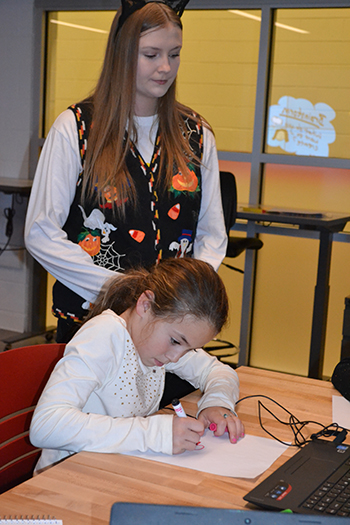
Mary Hadley watches a young visitor draw out her design.
MakerGirl has had a significant impact on the current CEO Stephanie Hein, who began her journey with the STEM Ed outreach program her junior year at Illinois while working on a degree in Molecular and Cellular Biology. In fact, working with MakerGirl so inspired her that she went on to get a Master’s of Education degree at the University of Michigan.
“I just fell in love with STEM education,” she admits, regarding her stint in MakerGirl her junior and senior years. “Especially when it comes to girls. That's kind of what inspired me getting my masters, and then I came back here.”
As the program’s CEO, seeking funding via corporate sponsorships is one of her big roles. “It's definitely a learning curve,” she acknowledges, “but people are pretty open and excited when they hear about our program.” She reports that setting up initial meetings seems to be going pretty well, but that the follow up takes some time. Currently, the three biggest supporters are Johnson Controls, who supported their road trips in the past, along with Abbot Labs and Parker Hannifin.
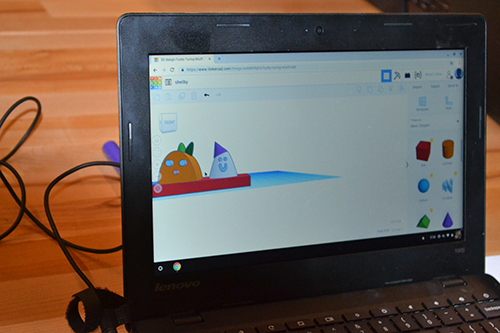
A young visitors spooky design on the computer.
Regarding funding, MakerGirl’s first big fundraiser, Chicago Charm, is coming up on November 29th in Chicago. It will be their first time ever trying to raise $10,000 in one night. Those interested in participating can register here. To find out more, see the MakerGirl website or Facebook page.
Hein explains why she tackled the role of MakerGirl CEO. “Personally, I'm doing it because I love MakerGirl, and I wanted to come back.”
She also considers working with a new startup to be a really unique opportunity. “It's something that only comes along once in your life. So being able to run a startup with a group of university students is...we're going to learn so much from it. I'm really excited about everything I'll learn. And I love leading the team of girls here; they're all great, and I love working with them.”
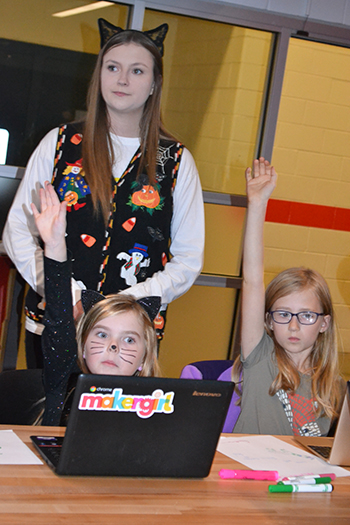
Mary Hadley with two young MakerGirl visitors.
Another member who is passionate about MakerGirl is Chemistry senior Mary Hadley. As the managing director, she oversees the directors over five key areas: academies, curriculum, finance, marketing, and internal. As the curriculum director, she’s in charge of all the curricula that’s created. She develops then shares the template for their presentations and sessions with the other academies, who then have freedom to pick the themes and come up with some of their own activities to do during the sessions.
What does Hadley envision for MakerGirl down the road? Her dream is to see it expand to multiple academies. In addition to the one at Northwestern, she thinks it would be great to set up five more over the next year. “I think just bringing MakerGirl to even more people through this same process that we have here on campus.”
As part of their expansion, key stakeholders plan to continue targeting universities as academy sites, because they think their model at Illinois works well. For one, usually a university has a space with 3D printers or one that would share space in order to acquire 3D printers. (The Illinois site has just such an arrangement with the Innovation Lab, which allows MakerGirl to use its space for its activities in exchange for using the group’s 3D printers.) Plus, key to MakerGirl’s strategy is having college students who are closer to the kids’ age and are passionate about STEM serve as role models.
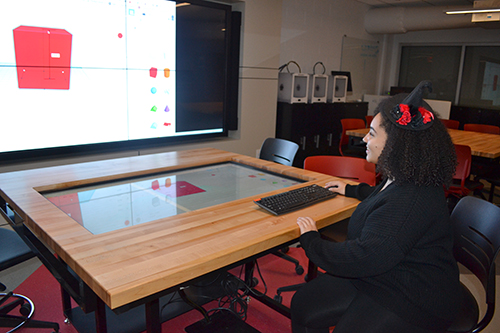
Olivia Cole shows a design on the big screen.
“We just think that having a college-age woman or man working with younger girls just lets them see that role model: "Oh, they got there, I can get there too!" So that's why we like that relationship.”
Plus, the mentoring aspect is a win-win, not just for the middle school girls, but for the college-age volunteers as well. In fact, Hadley reports that it significantly changed her college experience. That’s why she hopes to provide a STEM education outlet for more college girls, as well as being able to reach more younger girls. “I think just bringing us to campus and being a place that girls in STEM or girls that are passionate about teaching girls in STEM, have a place that they can talk, kind of throw ideas around, and create something as cool as our MakerGirl here. That's something I'm really excited for other people.”
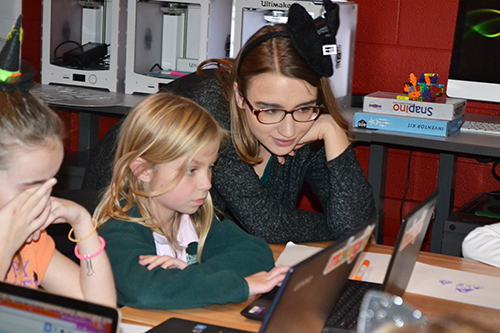
Amy Merkelz helps a young visitor with her design on the computer.
Hadley’s dream for MakerGirl is that its name becomes synonymous with STEM outreach for girls, at least in the Midwest: “I think that we would be really strong in the Midwest where people would know more about us, so when people come to campus, they want to find the MakerGirl. I think that's kind of what would be really cool.”
She adds that this happens with a lot of different clubs or RSO's on campus, and she hopes the same becomes true for MakerGirl—that high school students learn about them, so when they’re seniors, they’re “really excited to go off to university to be a part of MakerGirl. I think that would be my goal, just to be a name that's known so we always have a flowing number of new women that come in and help us.”
To help establish that MakerGirl pipeline, Hadley also envisions expanding to target older girls as well: “So we have our younger age, our older age, and you go off to be a university student and help out. So I think that step program would be really cool, but we really, really want to focus on our 7–10 age group first to make sure we're really strong in that aspect, because it's not a really saturated after-school program yet.”
Author/Photographer: Elizabeth Innes, Communications Specialist, I-STEM Education Initiative
More: CITL, K-6 Outreach , Maker Girl, Women in STEM, 2018
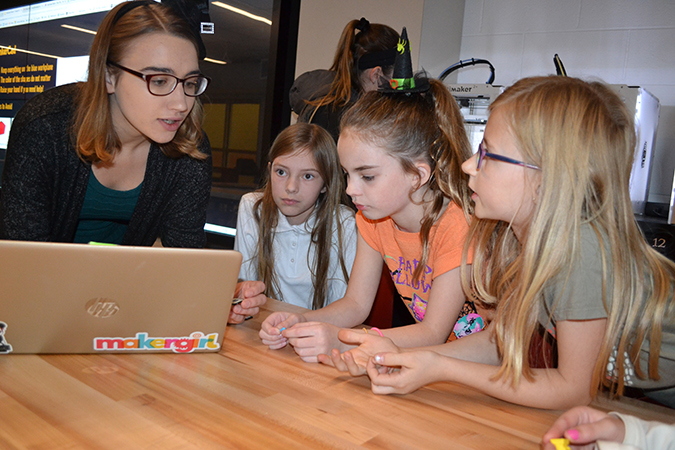
Amy Merkelz discussed 3D printing with young visitors.













.jpg)
















